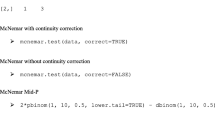Summary
The eggs laid by outbred females have been collected from the time of mating until the death of the females, and the proportion of eggs hatching recorded. Initially oyer 99 % of the eggs hatch after mating to outbred males; after about 30 days the quantity of sperm in the ventral receptacle is inadequate to ensure fertilization, and few or no eggs hatch. After mating to inbred males, the initial hatch varied from 43 to 84%, and a sharp decline in the proportion hatching occurred after about 10 days. Thus inbred males are inferior both in the quality and quantity of sperm produced.
Similar content being viewed by others
References
Bastock, M. &Manning, A. (1955). The courtship ofDrosophila melanogaster.Behaviour 8, 85.
Klabrke, J. M. &Maynard Smith, J. (1955). The genetics and cytology ofDrosophila subobscura.XI. Hybrid vigour and longevity.J. Genet. 53, 172.
Darwin, C. (1859).The Descent of Man. London: John Murray.
Dobzhansky, Th. (1951).Genetics and the Origin of Species. Columbia, University Press.
Hollingsworth, M. J. (1955). A gynandromorph segregating for autosomal mutants inDrosophila subobscura.J. Genet. 53, 131.
Hollingsworth, M. J. &Maynard Smith, J. (1955). The effects of inbreeding on rate of development and on fertility inDrosophila subobscura.J. Genet. 53, 295.
Koopman, K. F. (1950). Natural selection for reproductive isolation betweenDrosophila pseudoobscura andDrosophila persimilis.Evolution,4, 135.
Lack, D. (1953).The Life of the Robin. London: Penguin Books.
Lee, H. T-Y. (1950). A preliminary histological study of the insemination reaction inDrosophila gibberosa.Biol. Bull., Woods Hole,98, 25.
Mayr, E. (1948). The hearing of the new systematics on genetical problems.Ativans. Genet. 2, 205.
Milani. R. (1951a). Osservazioni sul corteggiamento deDrosophila subobscura.R.C. 1st. lombardo,84.
Milani, R. (1951b). Osservazioni comparitive ed esperimenti sulle modalita del corteggiamento nelle cinque species europee del gruppa ‘obscura’.R.C. 1st. lombardo,84.
Milani, R. &Rivosecchi, L. (1954). Gynandromorphs and rntersexuality inM. domestica.Drosophila Information Service,28, 135.
Patterson, J. T. (1946). A new type of isolating mechanism.Broc. Nat. Acad. Sci., Wash.,32, 202.
Patterson, J. T. &Stone, W. S. (1952).Evolution in the Genus Drosophila. New York: The Macmillan Company.
Rendel, J. M. (1943).D. pseudoobscura A × D. subobscura. Drosophila Information Service.17, 64.
Rendel, J. M. (1945). The genetics and cytology ofDrosophila subobscura. II. Normal and selective & matings inDrosophila subobscura.J. Genet. 46, 287.
Spieth, H. T. (1952). Mating behaviour within the genusDrosophila.Bull. Amer. Mus. Nat. Hist. 99, 395.
Spurway.H. (1948). The genetics and cytology ofDrosophila subobscura IV. An extreme example of delay in gene action causing sterility.J. Genet. 49, 126.
Spurway, H. (1.955a). The sub-human capacities for species recognition and their correlation with reproductive isolation.Proc. 11th Ornithological Congr. 1954 (Basel).
Spurway, H. (1955b). The causes of domestication.J. Genet. 53, 325.
Tinbergen.N. &Moynihan, M. (1952). Head flagging in the black-headed gull; its function and origin.Brit. Birds,45, 19.
Wheeler, M. R. (1947). The insemination reaction in intraspecific matings ofDrosophila. Univ. Tex. Publ. no. 4720, p. 78.
Author information
Authors and Affiliations
Rights and permissions
About this article
Cite this article
Smith, J.M. Fertility, mating behaviour and sexual selection inDrosophila Subobscura . J Genet 54, 261–279 (1956). https://doi.org/10.1007/BF02982781
Received:
Issue Date:
DOI: https://doi.org/10.1007/BF02982781




